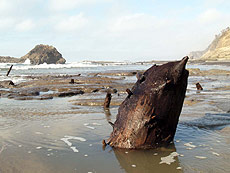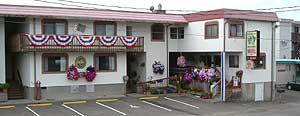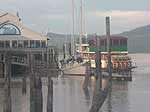 |
Oregon Coast Ghost Forest In Peril By Erosion That Exposed It |
|---|
Covering 180 miles of Oregon coast travel: Astoria, Seaside, Cannon Beach, Manzanita, Nehalem, Wheeler, Rockaway, Garibaldi, Tillamook, Oceanside, Pacific City, Lincoln City, Depoe Bay, Newport, Waldport, Yachats & Florence.
04/09/08
Secrets of the Season |
Oregon Coast Ghost Forest In Peril By Erosion That Exposed It
 |
| Barnacles cover Neskowin's ghost forest stumps |
(Oregon Coast) - This winter's wild weather and big waves scoured more sand than usual from the beaches of the Oregon coast, exposing a host of ‘ghost forests,’ the famed cannons of probable historical significance and other geologic oddities. Those ghost forests – stumps from ancient tree stands – showed up all over once the stormy waves subsided enough to let beachcombers find them. Cape Lookout, southern Lincoln County, Newport, Arch Cape and even rarely seen stumps just north of Pacific City popped up all over.
Now, sand levels are returning to normal and most of these kooky objects are saying goodbye for the rest of the year. But the chunk of ghost forest at Neskowin is visible year-round these days, and it appears it may be in trouble in the future. Sand levels reached so low this winter that the tree stumps were getting torn out by the roots and found on beaches five to 20 miles north.
 |
| Neskowin's forest is 1,000 to 2,000 years old |
Sand is replenishing in this rather secretive beach north of Lincoln City as well. So they’re safe for now. But this winter doesn’t bode well for the Neskowin strand in years to come.
|
Tradewinds Motel, Rockaway Beach. All rooms are immaculate and have TV’s, VCR’s and in-room phones w/ data ports. Oceanfronts have queen bed, a double hide-a-bed, kitchen, cozy firelog fireplace and private deck. Both types sleep up to four people. Others are appointed for a two-person romantic getaway, yet still perfect for those on a budget. Elaborate oceanfront Jacuzzi suite has two bedrooms, kitchen, double hide-a-bed, fireplace and private deck, sleeping as many as six. For family reunions or large gatherings such as weddings, some rooms can connect to create two-room and three-room suites. Some rooms pet friendly. 523 N. Pacific St., Rockaway Beach. (503) 355-2112 - 1-800-824-0938. www.tradewinds-motel.com |
Beach ranger David Woody, with Oregon State Parks and Recreation Department, said the stumps at Neskowin – about 1,000 to 2,000 years old – were showing so much they’re starting to get uprooted.
“I found some a ways up the road, at the beach at Winema Beach,” Woody said.
At the Oregon Department of Gem and Mineral Industries, geomorphologist Jonathan Allan and geologist Roger Hart said they were aware of several of these stumps being removed by erosion.
 |
| The stumps at Arch Cape showed up further south in 2007 |
“In my opinion, this past winter’s erosion of the buried forests has been more severe than ever before,” Hart said.” Waves have torn up Sitka spruce trees that were rooted in place for one to two thousand years at Neskowin, south of Proposal Rock, and at Cape Lookout State Park, along with great chunks of forest soil. They’ve strewn them all over beaches between Cascade Head and Cape Meares.”
Normally, the ghost forest tree limbs and stumps at Neskowin collect barnacles and other sea life clinging to it during times when the tide surrounds it, especially after periods when sand levels have rushed back up. It’s the same dynamic as many rocks at tide pools, where they suddenly show patches without sea life because sand levels have shrunk to expose an area that was normally off limits to these creatures.
But even these specimens at Neskowin – which are ironically the result of sand levels sinking low enough to expose them in the first place - are getting exposed so much they’re showing bare bark.
“I’ve seen a lot of stumps without barnacles on them, where the sand has gone away,” Woody said.
 |
| The bedrock beneath the sands was visible earlier this year just north of Pacific City |
There is some amount of debate about the origin of these things. Although it’s agreed upon that in order to freeze a forest like this in time, it must be rather quickly immersed in sand, clay, mud or some other earthly substance. This kills off the trees, but preserves them in time by keeping away the oxygen.
For a while, one big theory was that a massive tsunami knocked down the forest at Neskowin, or an enormous earthquake sunk it rather suddenly, as much as 25 feet below sea level.
Since then, state geologists like Allan and Hart maintain that what likely happened at Neskowin – and probably all the ghost forests of the Oregon coast – is that the landscape changed somehow and allowed the forest to be inundated with sand or whatever else. This happened rather suddenly in geologic terms, in a manner of decades.
In Neskowin and Newport, it’s seems sand did the forests in. Up north, in Arch Cape, the ghost forest there was entombed by clay and a big swamp encroaching on the trees.
Sand levels are still allowing a peek at the weird fun. Here’s a guide of oddities to look for. The beaches are filling up quickly with sand, however.
 |
| The Peter Iredale is showing more of its bones than usual this year |
Fort Stevens State Park. The wreck of
the Peter Iredale is one of the world’s most photographed shipwrecks,
lying on a beach at the southern end of this massive park. It’s
been here since the 1910’s. Exceptionally low sand levels caused
this to be quite exposed – more than normal. It’s one of those
spectacular seasons where you could see more of it than previous years,
at least for a while. Follow the signs to the wreck.
Hug Point State Park, S. of Cannon Beach. A few miles
south of town, this place has been host to ghost forests last year, but
this year has had some spectacular red towers. If tide permits –
and you’ll see them. They are mostly visible at low tides.
 |
| Ghost forest at Arch Cape earlier this year: these are entombed in slippery clay (photo Tiffany Boothe, Seaside Aquarium) |
Arch Cape. This tiny village, about a mile or so from Hug Point, is where the famed cannon were found. At the northern end, the ghost forest has popped up, as did strange structures known as red towers. These are about 4,000 years old and have been entombed in clay from an ancient swamp that was inundated with the stuff. You’ll find yourself walking on this soft, odd material. They too are mostly visible at low tides.
|
The Ocean Lodge. There will not be another property built like this in Cannon Beach in our lifetimes. Rare, premiere ocean front location; handsome, dramatic architecture and tasteful, fun (nostalgic) beach interiors. Overlooks Haystack Rock. 100 percent smoke free. Imaginative special occasion packages. Massive wood burning lobby fireplace. Library w/ fireplace, stocked with impressive book collection. Pet and family friendly. Lavish continental buffet breakfast. In-room fireplaces, mini-kitchens. Jacuzzi tubs in select rooms. DVD players, complimentary movies. Morning paper. Warm cookies. 888-777-4047. 503-436-2241. 2864 Pacific Street. Cannon Beach, Oregon. www.theoceanlodge.com |
Oceanside. Low sand levels at this village west of Tillamook will result in some wild sights, as more marine gardens come into view, and lower tides may allow you to wander close to the small set of Star Trek-like sea stacks that inhabit the area beyond the tunnel. Also, the tunnel may be more easily accessible, and likely clear of debris.
 |
| Stump barely sticking out of the sand at Cape Lookout |
Cape Lookout State Park. A ghost forest about 1,000 years old has been spotted along the beaches here early in the season. Most of it has disappeared. Small remnants remain poking out of the sand – but not for long.
Cape Kiwanda State Park. (You’ll find this on an unmarked, one-lane road just north of Pacific City). For a while, sand levels have dropped ten feet or more than usual – another example of the extreme erosion. This is probably filled up now, but you may spot some goodies. Small hints of a ghost forest have popped up, as has a unique rock formation that is about 16 million years old. You could for a time see the bedrock the sand sits on.
Neskowin. For a good glimpse of the ancient stumps year round, Neskowin is the place. But with lower sand levels, they are likely more spectacular than usual.
 |
| One stump at Neskowin has a shape not dissimilar to a hot tub |
Some especially large, even freakish specimens lurk here. One deceased tree trunk is so large, and with such a cavernous hole in the middle, it looks like a custom made hot tub.
To see these up close, you have to cross the creek here, which can have an especially strong, unpleasant current at times. It’s preferable to cross if it hasn’t been raining – or at least not raining much in days just before your visit.
Newport's Nye Beach and Agate Beach. Agate Beach is good for – you guessed it – agates, as well as other interesting rocks. Look to gravel bars that have been exposed by sand, or patches of rounded stones. Nye Beach may be good for looking for random historical artifacts.
 |
| At Moolack Beach, the stumps were sawed down to the root systems by early white pioneers |
Moolack Beach: The stumps here appear to be gone, but fossils may be spotted. Moolack Beach, north of Newport, sometimes hosts the appearance of root systems from a ghost forest, but only briefly this year. Sand levels didn’t quite sink low for long there. Interestingly enough, only roots show up because white pioneers in previous centuries sawed off the actual forest stumps.
The cliff walls here have been dropping interesting chunks of fossils, however. It is illegal to take these off the beach or break open the clumps of them that are coming out of the cliffs.
The bottom of these cliffs also boast the same soft, gray clay material that is found in Arch Cape. Often, you will see fossils embedded in these.
 |
| The stumps at Lost Creek were already barely visible when this photo was taken in late March |
Lost Creek and Thiel Creek. South of Newport, and just a tad north of Seal Rock, you’ll find Thiel Creek. About two miles north of there sits Lost Creek. These accesses provide a bundle of agate-rich spots, including the famed “Newport blues.”
Thiel Creek also hosts a ghost forest, although it was quickly disappearing when BeachConnection.net visited in late March. It, like the Moolack Beach one, is probably around 4,000 years old.
These beaches are also good for finding some fossils in the cliffs.
Ona Beach. Agates are reported here as well.
 |
 Inn
at Cannon Beach. Beautifully wooded natural setting at quiet south
end of Cannon Beach. Great during winter storms with a new book by
the fireplace – or when the sun is out for family fun and beach
strolling. Handsome beach cottage-style architecture. Lush flowering
gardens and naturalized courtyard pond. Warm, inviting guest rooms.
Continental buffet breakfast. Warm Cookies. Family and Pet Friendly.
Welcome gifts. Smoke-free. Complimentary Wireless Connectivity. Wine
and book signing events. 800-321-6304 or 503-436-9085. Hemlock At
Surfcrest, Cannon Beach, Oregon. www.atcannonbeach.com. Inn
at Cannon Beach. Beautifully wooded natural setting at quiet south
end of Cannon Beach. Great during winter storms with a new book by
the fireplace – or when the sun is out for family fun and beach
strolling. Handsome beach cottage-style architecture. Lush flowering
gardens and naturalized courtyard pond. Warm, inviting guest rooms.
Continental buffet breakfast. Warm Cookies. Family and Pet Friendly.
Welcome gifts. Smoke-free. Complimentary Wireless Connectivity. Wine
and book signing events. 800-321-6304 or 503-436-9085. Hemlock At
Surfcrest, Cannon Beach, Oregon. www.atcannonbeach.com. |
 |
|
Arch
Cape Property Services.
Dozens of homes in that dreamy,
rugged stretch between Cannon Beach and Manzanita known as Arch
Cape. Oceanfront and ocean view , or just a short walk from the
sea. |
RELATED STORIES
Click here for video of Dec. storm aftermath
Oregon Coast Best of Awards for the Year And the winners are: best of Oregon coast restaurants, lodgings, science, odd events in nature and stunning moments for 2007
Watching Transformations of Oregon Coast Beaches Seasons change and so do beaches, revealing different sides and a variety of eye-popping sights
Staggeringly Cool Ideas for Oregon Coast Romance Be it the season of Valentine's or be it any time of the year, Oregon's coastline has essentially cornered the market for cuddle-inducing possibilities and gushy activities for the hand-holding set
Day or Night Mysteries and Merriment on Oregon Coast It's more than just nightlife that comes to life, but the beaches offer major opportunities
Oregon Coast Travel Site Goes Wireless Provides Lodging Reports - Oregon Coast Beach Connection now has mobile lodging and dining listings, along with weekly lodging availability reports
|
Oregon coast mileage chart & map Day trips, suggested itineraries Search for Oregon Coast Subjects, Articles Oregon Coast Complete Guides every beach access, attraction |
|||||||||||||
OR
TAKE THE VIRTUAL TOUR |
|||||||||||||
|



































